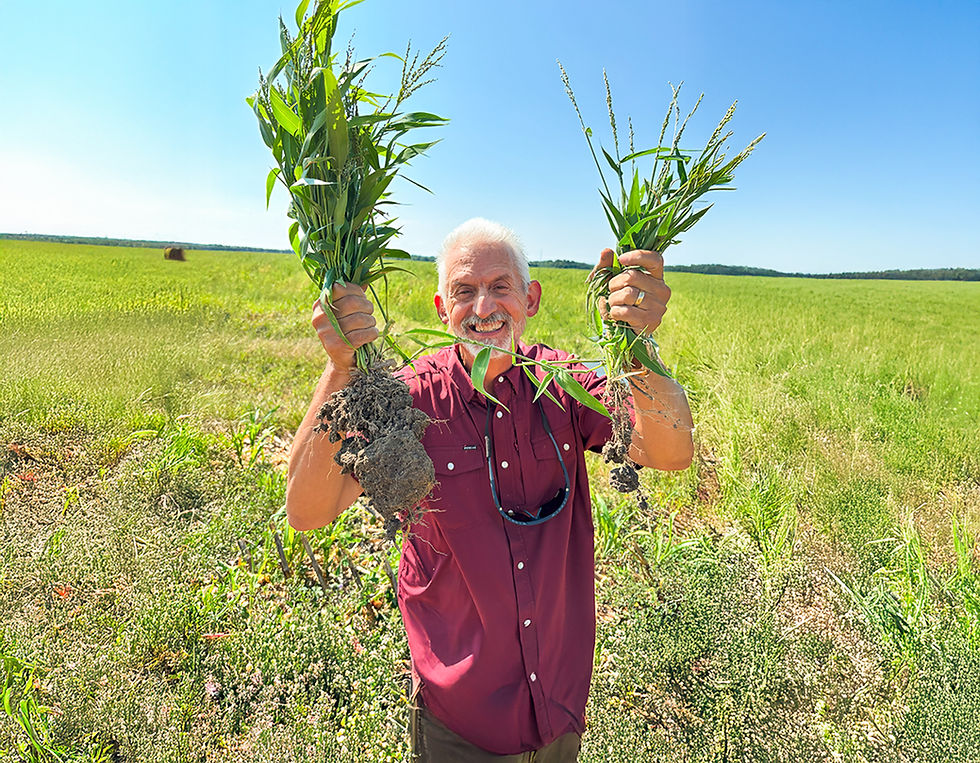From Skepticism to Soil Health: Ray Archuleta Tackles Tough Questions in the Field
- Buz Kloot, Ph.D.

- Sep 10
- 3 min read

It was the kind of late-summer afternoon when the land itself feels like it’s holding its breath. Ray Archuleta had come in from his home in Missouri to speak at the SC Forage and Grazing Lands Coalition, but before he ever set foot in a lecture hall, we wanted him out on the land, where his words always seem to take root.
We brought him to Jason Carter’s farm — a familiar place for us, a living classroom. On one side of a dirt track: Jason’s ground, managed with no-till, long rotations, cover crops, and livestock. On the other hand, the very same Orangeburg loamy sand was managed conventionally with tillage and low diversity. Two fields, fifty feet apart, the same soil series, divided only by management.
We’ve often brought visitors here to see the contrast, and the soils still spoke clearly. But this time what struck us most wasn’t the dirt underfoot — it was the weeds. Both fields had recently come out of corn. In the conventional ground, Palmer amaranth was already charging ahead, while Jason’s field, still green with cover, held weeds only here and there. Ray grinned at the sight. “If you want to preserve weed seeds,” he said, “bury them with tillage.”
Tackling the Sticking Points
For months, our Growing Resilience community online has been hashing out the hard questions. Many of them made their way into the field with us that afternoon.
“No-till makes soils hard as concrete.”
Ray didn’t dodge. “Yes, no-till soils can get compacted. But the cure isn’t more steel — it’s living roots. Life creates porosity. There’s no piece of equipment on this planet that can do what biology does.”
“Diversity just means more disease.”
Ray shook his head. “Nature is self-healing, self-regulating. The real cause of disease is planting the same thing over and over. Nature wants diversity. The soil wants different roots, different exudates, different foods.”
“Cover crops are just another cost.”
Ray told us he prefers the term “service crops.” “Because they serve the next corn, the next soybean, the microbes, the climate — they serve life itself.”
“Livestock don’t belong on cropland.”
Ray was emphatic: “Nature does not farm without animals. If I were forced to grow corn and soybeans, I’d fence my whole farm and run livestock. Animals bring freedom from the bank — but only if you’re ready to manage them well.”
“Forbs are weeds on rangeland.”
Ray reminded us: “Grasslands are not just grasses. They have legumes, forbs, deep-rooted plants that feed different microbes. Forbs bring nutrients to cattle that grasses don’t. Healthy land is a supermarket and a pharmacy, all at once.”
“Longer rotations don’t pay.”
Ray countered with what research — and farmers like Darren Williams in Kansas — have shown: “Bring wheat or oats into a corn-soy rotation and inputs drop, infiltration rises, pest cycles break. Profitability isn’t in one crop — it’s in the whole rotation.”
“No-till just means more chemicals.”
Ray leaned in on this one. “As soils get healthy, they need fewer inputs. Weed populations shift. Fungicides, insecticides, fertilizers — they all go down. The soil can’t get healthy without living covers, but when it does, you need less chemistry, not more.”
From Questions to Conversations
We filmed it all, not as a lecture, but as a conversation with the land itself. The tough questions came straight from our readers and neighbors, sharpened by skepticism. The answers came with soil in hand, with earthworms dangling, with clods breaking or holding depending on the management.
Ray often returns to a single line: “The soil is alive.” Yet, as he admitted that afternoon, “I’ve only been impressed with maybe 10 or 15 producers for their knowledge of the soil — and I meat thousands. We’re at a very low level of understanding.”
That truth is harder to ignore when you see two fields side by side, one brittle and one full of life. The outing reminded us that skepticism is not an obstacle — it’s an opening. When you take the hard questions out into the land, the answers are waiting.

Visit these “Growing Resilience Through Our Soils” information pages:
1. Podcast page for drought planning fact sheets, Q&As, news, podcasts, and more.
2. Video page to watch videos of other ranchers’ journeys toward improved rangeland/pasture.
3. Follow Growing Resilience on social media:
4. Our homepage: www.growingresiliencesd.com





Comments